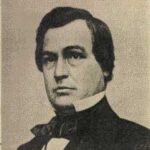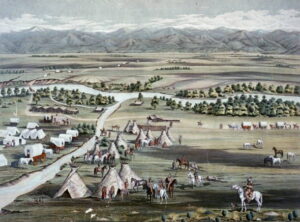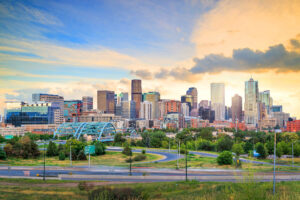
 Have you ever wondered how a city got its start and its name? For one small frontier town in Kansas Territory, United States, it all began on October 29, 1858, when the first store opened. The store was probably situated near the confluence of the South Platte River and Cherry Creek, the present-day location of central Denver. This junction of rivers also served as a cultural crossroads between the Southern Arapaho and white settlers pursuing gold rumors. One short month later the small frontier town would take on the name of Denver in a shameless ploy to curry favor with Kansas Territorial Governor James W Denver.
Have you ever wondered how a city got its start and its name? For one small frontier town in Kansas Territory, United States, it all began on October 29, 1858, when the first store opened. The store was probably situated near the confluence of the South Platte River and Cherry Creek, the present-day location of central Denver. This junction of rivers also served as a cultural crossroads between the Southern Arapaho and white settlers pursuing gold rumors. One short month later the small frontier town would take on the name of Denver in a shameless ploy to curry favor with Kansas Territorial Governor James W Denver.
Denver was conceived by a town promoter and real estate salesman from Kansas named William H Larimer Jr, and that first store was established to cater to miners extracting placer gold found a year earlier at the confluence of Cherry Creek and the South Platte River. Many small frontier towns have simply become ghost towns now, but that was not to be the case for Denver. By 1859, the area had seen an influx of tens of thousands of gold seekers. Still, it’s existence would not be without struggle. The placer deposits were  diminishing, prompting most miners to either return home or venture westward into the mountains in pursuit of the more abundant veins.
diminishing, prompting most miners to either return home or venture westward into the mountains in pursuit of the more abundant veins.
By 1860, Larimer’s fledgling town was on the brink of failure. Despite its central location for servicing mining camps along the Rocky Mountain Front Range, Denver lacked the necessary rail and water transportation routes for affordable goods delivery. The transcontinental Union Pacific Railroad, launched in 1869, initially bypassed Denver. However, in 1870, Denver started to break free from its geographical isolation when the Kansas Pacific Railroad arrived from the east and the 105-mile Denver Pacific Railway connected Denver to the Union Pacific line at Cheyenne. Subsequent rail lines linked Denver with the flourishing mining areas in the Rockies, and by the mid-1870s, Denver was prospering as a railroad hub and a focal point of the western mining industry. The railroads had saved the town.
By 1890, Denver’s population exceeded 106,000, ranking it as the 26th largest urban area in the United States and giving it the moniker “Queen City of the Plains.” The Silver Panic of 1893 abruptly halted the economic 
 boom, which was only partially revived by the 1894 gold discoveries at Cripple Creek. So, there was still some concern about the viability of the city. The increasing importance of farming and ranching helped stabilize the city’s economy by reducing reliance on mining and quite possibly saving the city. Still, the cyclical nature of economic booms and busts continues as a dominant force in Denver, as well as in many other western cities, for much of the 20th century.
boom, which was only partially revived by the 1894 gold discoveries at Cripple Creek. So, there was still some concern about the viability of the city. The increasing importance of farming and ranching helped stabilize the city’s economy by reducing reliance on mining and quite possibly saving the city. Still, the cyclical nature of economic booms and busts continues as a dominant force in Denver, as well as in many other western cities, for much of the 20th century.


One Response to Queen City Of The Plains